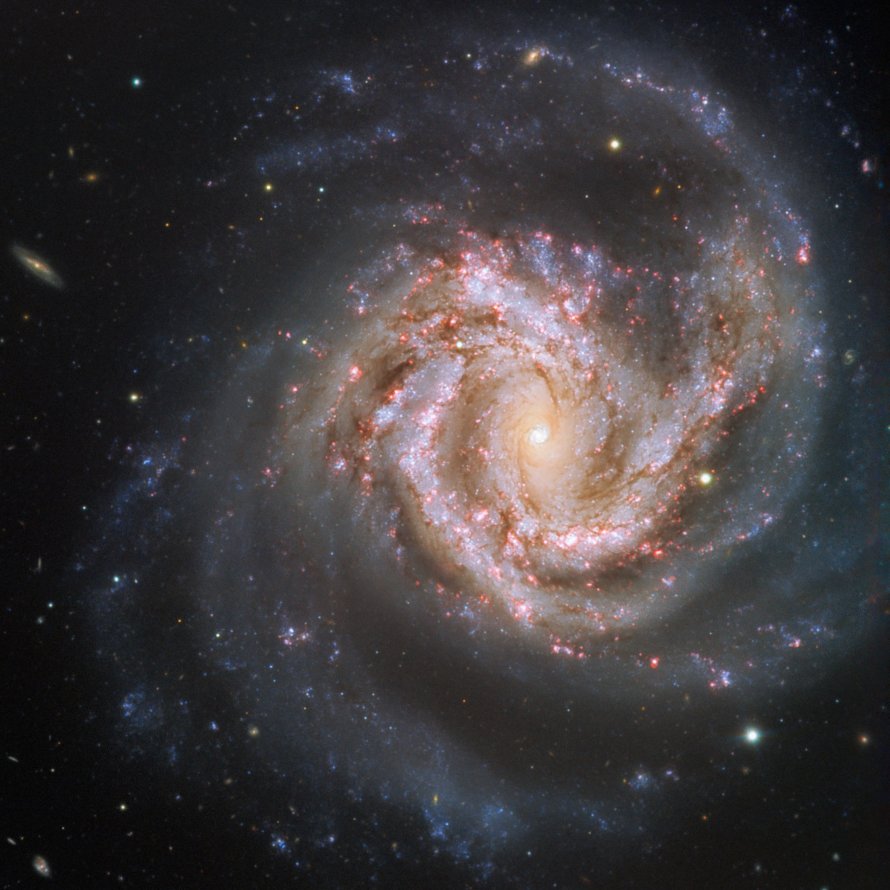M61 (NGC 4303)
Messier 61 (NGC 4303) is a spiral galaxy located in the constellation Virgo in the Virgo Cluster of galaxies. M61 is 52500000 light years away from Earth.
M61 is best viewed during late spring, is magnitude 10.2, and can be viewed with small telescope. M61 is 6.5' x 5.8' in apparent size. For reference, the full moon is 30'.
Observing difficulty: Intermediate
- Name:
- Type:
- spiral galaxy
- Constellation:
- Virgo
- NGC or IC:
- NGC 4303
- Magnitude:
- 10.2
- Viewing:
- small telescope
- Size:
- 6.5' x 5.8'
- Distance (light years):
- 52500000 LY
- RA:
- 12h 22.0m
- Dec:
- 4 29'
- Season:
- late spring
- Galaxy group:
- Virgo Cluster
- Messier Marathon #:
- 64
* The naked eye can see up to magnitude ~7-8 objects under ideal dark sky conditions.
A Spiral Galaxy in the Virgo Cluster
Located in the constellation Virgo, Messier 61, or M61, is one of the prominent galaxies in the Virgo Cluster. Its beautiful spiral structure, coupled with its relative proximity, makes it an attractive object for astronomers and astrophotographers alike.
Historical Background
M61 was discovered by Italian astronomer Barnaba Oriani on May 5, 1779. It is worth noting that on the same night, Charles Messier, the French astronomer behind the eponymous Messier catalog, had mistaken M61 for a comet. It was only a few days later that Messier realized his error and recognized M61 as a nebula.
Physical Characteristics
M61 is a type SAB spiral galaxy, characterized by somewhat loosely wound arms and a relatively small bar-like structure cutting through its nucleus. This type of spiral galaxy is an intermediate form between a regular spiral galaxy (type SA) and a barred spiral galaxy (type SB). The galaxy's disk is permeated by multiple spiral arms, filled with dust lanes and star-forming regions that present as blueish knots when viewed through a powerful telescope.
Magnitude and Size
Messier 61 has an apparent magnitude of about 9.7, making it a challenging object to see with the naked eye even under perfect dark-sky conditions. However, it can be readily observed using amateur telescopes or good binoculars. The galaxy covers an area of approximately 6.0 by 5.5 arc minutes in the sky, which is roughly one-fifth of the diameter of the full moon.
Scientific Significance
With its intricate spiral structure, M61 provides an excellent opportunity for astronomers to study star formation processes in spiral arms. The galaxy has been a site of eight confirmed supernovae since 1926, making it a fertile ground for studying these catastrophic stellar events and their roles in galactic evolution.
Finding and Viewing Messier 61
Locating M61 in the night sky is relatively straightforward for those in the Northern Hemisphere during spring, when the Virgo constellation is high in the sky. The galaxy is situated near the midpoint between the stars ? Virginis and ? Leonis. While M61 can be a challenging target for smaller telescopes due to its diffuse nature, larger amateur telescopes can reveal the brighter center and perhaps some hint of the spiral structure.
It's recommended to observe M61 under dark skies, far away from city light pollution, to achieve the best viewing results. As is the case with many faint deep-sky objects, the use of averted vision - looking slightly to the side of the object rather than directly at it - can also help to discern more details.



